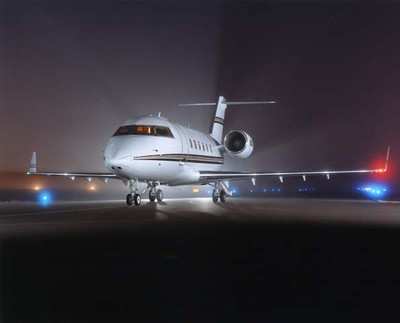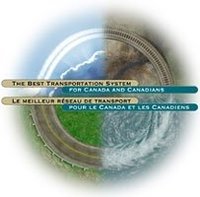Challenger 600 Operators Told To Check For Ice
If you fly a Bombardier Challenger 600 series aircraft, the FAA
wants you to be more careful inspecting for ice and frost on the
wings. That's the gist of a new NOTAM from Washington, after two
high-profile mishaps since November.

As ANN has reported, the first incident happened
in Montrose, CO, when the son of NBC Sports executive Dick Ebersol
was killed in the take-off of a Challenger 601. The
pilot reportedly declined an offer to de-ice just before
take-off.
Then, three weeks ago, another Challenger series
aircraft ran off the end of the runway at Teterboro, NJ, injuring
13 people.
The NTSB has not yet issued probable cause findings in either
case.
The Washington Post reports the FAA's decision came after "a
report that even small amounts of frost, ice, snow or slush on the
wing leading edges or forward upper wing surfaces can cause an
adverse change" that could lead to a stall.
"We are issuing this [directive] to prevent possible loss of
control on take-off resulting from even small amounts of frost,
ice, snow or slush on the wing," says the directive (see excerpts,
below).
NOTAM Excerpts
 Airworthiness Directives;
Bombardier Model CL-600-2B19 (Regional Jet Series 100 & 440)
Airplanes and Model CL-600-1A11 (CL-600), CL-600-2A12 (CL-601), and
CL-600-2B16 (CL-601-3A, CL-601-3R, and CL-604) Series Airplanes
Airworthiness Directives;
Bombardier Model CL-600-2B19 (Regional Jet Series 100 & 440)
Airplanes and Model CL-600-1A11 (CL-600), CL-600-2A12 (CL-601), and
CL-600-2B16 (CL-601-3A, CL-601-3R, and CL-604) Series Airplanes
SUMMARY: The FAA is adopting a new
airworthiness directive (AD) for all Bombardier Model CL-600-2B19
(Regional Jet Series 100 & 440) airplanes and Model CL-600-1A11
(CL-600), CL-600-2A12 (CL-601), and CL-600-2B16 (CL-601-3A,
CL-601-3R, and CL-604) series airplanes. This AD requires revising
the airplane flight manuals to include a new cold weather
operations limitation. This AD is prompted by a report that even
small amounts of frost, ice, snow, or slush on the wing leading
edges or forward upper wing surfaces can cause an adverse change in
the stall speeds, stall characteristics, and the protection
provided by the stall protection system. We are issuing this AD to
prevent possible loss of control on take-off resulting from even
small amounts of frost, ice, snow, or slush on the wing leading
edges or forward upper wing surfaces.
DATES: Effective February 22, 2005.
SUPPLEMENTARY INFORMATION: Transport Canada
Civil Aviation (TCCA), which is the airworthiness authority for
Canada, notified the FAA that an unsafe condition may exist under
certain operating conditions on all Bombardier Model CL-600-2B19
(Regional Jet Series 100 & 440) airplanes and Model CL-600-1A11
(CL-600), CL-600-2A12 (CL-601), and CL-600-2B16 (CL-601-3A,
CL-601-3R, and CL-604) series airplanes. TCCA advises that even
small amounts of frost, ice, snow, or slush on the wing leading
edges or forward upper wing surfaces of these airplanes can cause
an unsafe condition where an adverse change in the stall speeds,
stall characteristics, and the protection provided by the stall
protection system may result in reduced controllability of the
airplane. TCCA advises that cold weather operational requirements
for the subject airplane flight manuals should include wing leading
edge and upper wing surface inspections using visual and tactile
means in identifying potential contamination by frost, ice, snow,
or slush.
Relevant Temporary Revision Information
Bombardier has issued temporary revisions (TRs) to the
applicable Bombardier airplane flight manuals (AFMs) as listed in
the following table. The TRs include a new take-off limitation to
emphasize the requirement for an aerodynamically clean airplane
during cold weather operations. The TRs specify that, in addition
to a visual check, a tactile check must be done to determine that
the wing is free from frost, ice, snow, or slush when certain
weather conditions exist.
FAA's Determination and Requirements of This AD
These airplane models are manufactured in Canada and are type
certificated for operation in the United States under the
provisions of section 21.29 of the Federal Aviation Regulations (14
CFR 21.29) and the applicable bilateral airworthiness agreement.
Pursuant to this bilateral airworthiness agreement, TCCA has kept
the FAA informed of the situation described above. We have examined
TCCA's findings, evaluated all pertinent information, and
determined that we need to issue an AD for products of this type
design that are certificated for operation in the United
States.
Therefore, we are issuing this AD to prevent possible loss of
control on take-off resulting from even small amounts of frost,
ice, snow, or slush on the wing leading edges or forward upper wing
surfaces. This AD requires revising the airplane flight manuals to
include a new cold weather operations limitation.
Differences Between This AD and the Canadian Airworthiness
Directives
 Due to the degree of urgency
associated with the subject unsafe condition, this AD specifies a
compliance time of within 5 days after the effective date of this
AD in order to closely coincide with the compliance times specified
in the Canadian airworthiness directives. Canadian airworthiness
directive CF-2005-01 specifies a compliance time of within 14 days
after February 2, 2005 (the effective date of Canadian
airworthiness directive CF-2005-01). Canadian airworthiness
directive CF-2005-03 specifies a compliance time of within 14 days
after February 8, 2005 (the effective date of Canadian
airworthiness directive CF-2005-03).
Due to the degree of urgency
associated with the subject unsafe condition, this AD specifies a
compliance time of within 5 days after the effective date of this
AD in order to closely coincide with the compliance times specified
in the Canadian airworthiness directives. Canadian airworthiness
directive CF-2005-01 specifies a compliance time of within 14 days
after February 2, 2005 (the effective date of Canadian
airworthiness directive CF-2005-01). Canadian airworthiness
directive CF-2005-03 specifies a compliance time of within 14 days
after February 8, 2005 (the effective date of Canadian
airworthiness directive CF-2005-03).
FAA's Determination of the Effective Date
An unsafe condition exists that requires the immediate adoption
of this AD; therefore, providing notice and opportunity for public
comment before the AD is issued is impracticable, and good cause
exists to make this AD effective in less than 30 days.
Applicability
This AD applies to all Bombardier Model CL-600-2B19 (Regional
Jet Series 100 & 440) airplanes and Model CL-600-1A11 (CL-600),
CL-600-2A12 (CL-601), and CL-600-2B16 (CL-601-3A, CL-601-3R, &
CL-604) series airplanes; certificated in any category.
Unsafe Condition
This AD was prompted by a report that even small amounts of
frost, ice, snow, or slush on the wing leading edges or forward
upper wing surfaces can cause an adverse change in the stall
speeds, stall characteristics, and the protection provided by the
stall protection system. The FAA is issuing this AD to prevent
possible loss of control on take-off resulting from even small
amounts of frost, ice, snow, or slush on the wing leading edges or
forward upper wing surfaces.
Compliance
You are responsible for having the actions required by this AD
performed within the compliance times specified, unless the actions
have already been done.
 ANN's Daily Aero-Linx (04.13.24)
ANN's Daily Aero-Linx (04.13.24) ANN's Daily Aero-Term (04.13.24): Beyond Visual Line Of Sight (BVLOS)
ANN's Daily Aero-Term (04.13.24): Beyond Visual Line Of Sight (BVLOS) Airborne 04.09.24: SnF24!, Piper-DeltaHawk!, Fisher Update, Junkers
Airborne 04.09.24: SnF24!, Piper-DeltaHawk!, Fisher Update, Junkers Aero-News: Quote of the Day (04.14.24)
Aero-News: Quote of the Day (04.14.24) ANN's Daily Aero-Term (04.14.24): Maximum Authorized Altitude
ANN's Daily Aero-Term (04.14.24): Maximum Authorized Altitude





